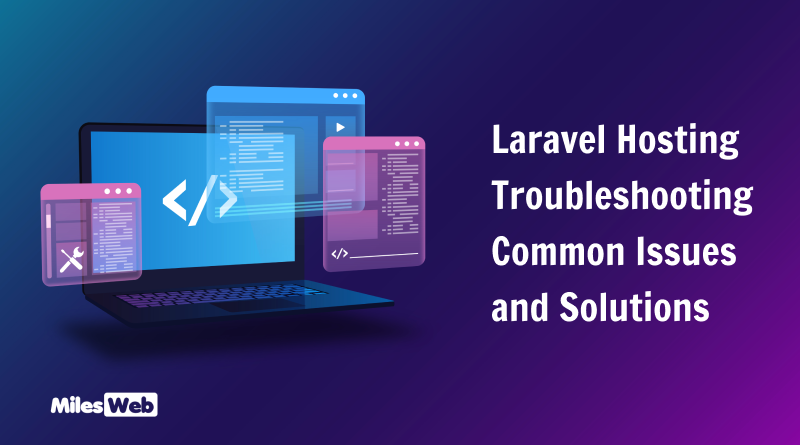20 Jan

|
Getting your Trinity Audio player ready...
|
Hey there, fellow Laravel enthusiasts! You’re not alone if you’ve ever developed a Laravel application and encountered hosting issues. Hosting your Laravel project can sometimes be a challenging endeavour, but fear not!
In this blog post, we’ll explore some common issues you might encounter while hosting your Laravel application and provide practical solutions to help you overcome these challenges. These tips will assist you in optimizing your Laravel hosting experience.
Table of Contents
The White Screen of Error
Ah, the infamous white screen! It’s every Laravel developer’s nightmare. You deploy your application, and instead of the expected content, you’re greeted by a blank page. Frustrating, isn’t it? Don’t worry; there are a few things you can check to get to the bottom of this issue:
- Verify that your environment variables are correctly set in the .env file.
- Make sure your server has the necessary PHP extensions installed.
- Check the Laravel logs for any error messages that might provide clues to the issue.
- Ensure that your server meets the minimum PHP version required by Laravel.
And if you’re incorporating Node.js into your project, make sure to address any Nodejs hosting considerations to ensure seamless integration and optimal performance.
Permission Problems
Laravel relies heavily on file and directory permissions, and incorrect permissions can lead to a myriad of issues. Here’s how you can troubleshoot permission problems:
Make sure your storage and bootstrap/cache directories are writable by the server.
Set appropriate ownership and permissions for your project files using commands like Chown and CHMOD.
Double-check your .env file for any misconfigurations related to file paths.
“404 Not Found” Errors
Encountering a “404 Not Found” error is frustrating, especially when you’re certain that the route exists. Here’s what you can do to tackle this issue:
Verify that your web server’s document root points to the public directory of your Laravel project.
Ensure that you have the appropriate rewrite rules configured in your web server (e.g., Apache .htaccess or Nginx configuration).
Double-check your route definitions and make sure they are correctly defined.
Memory Limit Exceeded
If you notice errors related to the memory limit being exceeded, you may need to adjust your server’s PHP settings. Here’s how you can handle it:
Locate the php.ini file on your server and increase the memory_limit setting.
If you don’t have direct access to the php.ini file, you can try modifying the .htaccess file or the Laravel php.ini file located in the public directory.
Database Connection Issues
Laravel relies on a database for storing and retrieving data, and connection issues can bring your application to a halt. Here are some steps to troubleshoot database connection problems:
- Ensure that your database credentials in the .env file are accurate.
- Verify that your database server is up and running.
- Check for any firewall rules that might be blocking the connection to your database server.
Benefits of Laravel Framework
Here is the list of advantages that you will get with the Laravel framework.
1. Security
Website security is the first concern that most of the website owners consider. Laravel has advanced security features to enhance the website’s protection. There will be no hacking attempts, so your website operation will work smoothly. Laravel uses a Bcrypt hashing algorithm, which means there are no store passwords.
With the Laravel framework, developers easily solve essential security problems. The list of problems includes scripting, query spoofing, and SQL injection. As a secured framework, developers fix security vulnerability issues before the deployment.
2. High Performance Under Heavy Server Loads
With the growing business, website traffic amount will also increase. Hence, websites developed in this framework handle multiple requests faster than other frameworks. This framework uses a unique messaging queue system. As a result, postponing certain website tasks like sending emails is possible with it.
Your website will be able to handle the other jobs more quickly if you can manage the time-consuming ones. Additionally, by doing this, you can eventually lower your hosting expenses while also maintaining the server’s uptime for the website.
3. Easy Maintenance and Support for Laravel Projects
Regardless of their complexity or size, websites created with Laravel are simple to maintain. So, let’s say you decide to add some new features to your website after a few years. A new developer may easily pick up where your previous developers left off. A site created using Laravel is simple to maintain over time because of its great features, including clean code, MVC design (which separates logic and presentation), and built-in functionalities.
Conclusion
Hosting a Laravel application can be a bumpy ride, but armed with the knowledge of common issues and their solutions; you can navigate through the challenges with ease. Remember to double-check your configuration files, permissions, and server settings, and don’t hesitate to consult the Laravel documentation or seek help from the vibrant Laravel community. Happy hosting, and keep coding with Laravel!


